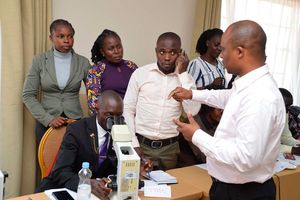Kemri unveils malaria prevention tool

Older children were more likely to benefit from the spatial mosquito repellent compared to the younger ones.
Scientists from the Kenya Medical Research Institute (Kemri) have come up with a new malaria prevention tool that if adopted, will help in reducing new infections in the country.
The tool – Mosquito Shield, is a spatial repellent product that the scientists say reduces new malaria infections by about 32 per cent.
Their findings were published in the scientific journal the Lancet, showing that the product provides additional reduction in malaria’s threat beyond the protection offered by Insecticides Treated Nets (ITNs).
The study was conducted in Busia, in western Kenya.
“Outcomes from this trial satisfy one of two trials required by WHO for assessing spatial repellent public health value and developing global health policy for the spatial repellent intervention class,” explains the study
Prof Elijah Songok, Acting Director General of Kemri said in a statement that despite the country making strides against malaria, areas like Busia County experience rates of malaria that mirror counties with the highest burdens.
“People in those areas urgently need new tools and tailored solutions. We are proud to see the impact of this work already translating into action for millions of people at risk of malaria here,” he said.
The researchers say that a spatial repellent is a new option that will add to the list of malaria reducing interventions such as bed nets, indoor residual spraying, coils or managing the mosquito through its larva source.
They explain that the products are designed to decrease human exposure to malaria by releasing active ingredients into the air that disrupt mosquito– human contact.
“Spatial repellents have been used for prevention of insect bites, and there exists a body of evidence of spatial repellents' efficacy in reducing human–vector contact,” the study shows.
Unlike other intervention tools that only have an effect in a specific household, the new spatial repellent reduces infections even in neighbouring households as well.
“The reduction in incidence observed in neighbouring villages indicates that at high coverage, spatial repellents might offer benefit, as has been observed previously in trials of ITNs,” explains the study.
Older children were more likely to benefit from the spatial repellent compared to the younger ones.
“Older children may have different behavioural practices than younger children in relation to malaria risk that could help to explain differences in protective efficacy,” the study indicates.
The scientists hope that the new evidence on the public health value for consideration of spatial repellent will be included in the country's National Malaria Control Programs.
Dr Bernard Nahlen, a professor of biological sciences and director of the Eck Institute for Global Health at the University of Notre Dame –who funded the study, advises that this method should be used together with insecticide-treated nets, rapid diagnosis, effective treatment and case management.
“This approach could reinforce protection for vulnerable groups, including children, pregnant women, and displaced populations,” he said.
“This is a powerful result. There is no magic bullet for malaria, but a one-third additional decrease in transmission on top of mosquito nets could translate into tens of thousands of lives saved each year,” added Dr Nahlen.
In an interview with Nation, Dr Eric Ochomo, one of the study’s author and Head of Entomology Section in Kemri explained that the goal of the study was to find out whether the participants who were given the repellent had a longer delayed infection of malaria compared to those that did not receive any, as well as establish the repellent’s efficacy in reducing malaria infections.
“This is called an incident study, where we monitor a clean cohort. For this specific one, we monitored within a two-year period and we measured the findings from the time they get the first infection to find out if the time is longer,” he explained.
Dr Ochomo explains that the new tool has a similar concept with mosquito coils, only that unlike coils that you have to light up every time you want to use, this one is mounted on a wall like one would a photo frame in their house. Its protection impacts last up to one month. They are thin sheets of transparent materials and one side is coated with insecticides.
He explains that when they gave the repellents to some houses leaving others to check whether those left without will have new infections –they found out that there were less infections because the repellent not only chases away the mosquitoes but actually kills them.
The study shows that there are infrequent mild side effects, Dr Ochomo explains that the most common one was the sneezes and some people could get eye irritation and start tearing up.
“They are very mild, they resolve within the first two weeks,” he reassured.
The tool is not sold in the retail market, and can only be distributed by the government through the National Malaria Control Program should they adopt it.
The scientists are currently studying an even longer-acting spatial repellent that could last up to one year in a household.
Kenya developed guidelines on the use of spatial repellents in October this year, and the Health ministry will likely approve those next year.
Malaria in the country continues to burden the healthcare system in the country, contributing to 19 per cent of outpatient consultations and 10 per cent of hospital admissions.





